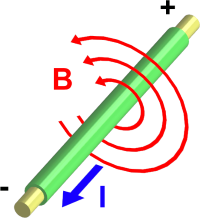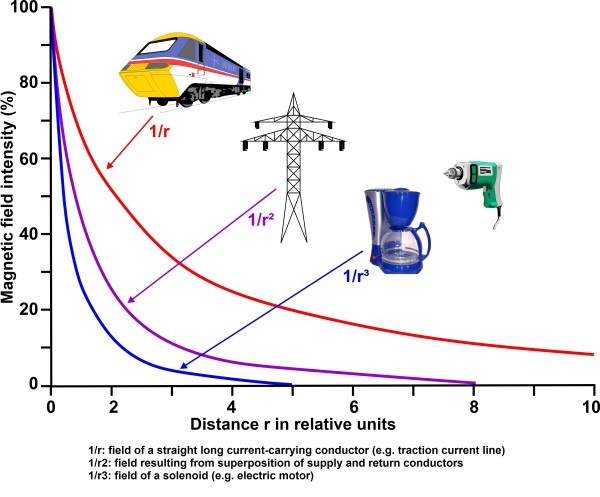Magnetic fields
Magnetic fields result from moving charges (current) or arise from permanent magnets. Permanent magnets have a static magnetic field (0 Hz) with largely constant strength and direction (polarity), as e.g. in case of the earth’s magnetic field.

photo: Geek3, license: CC BY-SA 3.0, via Wikimedia Commons
In conductors static magnetic fields (with DC) or alternating magnetic fields (with AC) are formed, depending on the current feed. In case of alternating magnetic fields the polarity changes according to the cyclic changes of the current flow direction in the field-creating electrical conductor (e.g. 100 polarity changes per second with 50 Hz AC). In case of static magnetic fields the polarity is nearly unchanged.

photo: Stannered, license: CC BY-SA 3.0, via Wikimedia Commons
The magnetic field strength around a conductor increases with rising electric current strength and decreases with growing distance from the field source. It is depending on the type of source how fast the field decreases (see figure).

The strength of the magnetic field is measured in current per meter (A/m), and referred to as the magnetic field strength H. In contrast to the electric field strength E, the magnetic field strength does not represent the total electromagnetic force of the magnetic field, since this force will depend not only on the current intensity, but also on the material that is penetrated by the magnetic field. Thus, to describe the strength of the magnetic field in matter, the magnetic flux density B is used with the unit Tesla (T). The magnetic flux density is often also referred to as magnetic induction. The magnetic flux density B is linked to the magnetic field strength H by a material constant, the magnetic permeability µ.
B = µ × H
In simple terms, the magnetic permeability µ (also called magnetic conductivity) is a measure of the permeability of materials for magnetic fields.